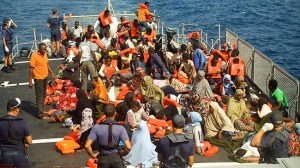Europe’s migrant influx has become a crisis

Photo credit: Malta UNESCO Youth Association
A tragedy in which 700 would-be illegal migrants were feared drowned off Malta this month after people traffickers rammed their boat has catapulted the issue of migration into Europe to a new level.
The boat was rammed by the traffickers after the passengers refused to move to smaller, less seaworthy vessels.
The International Organisation for Migration (IOM) reported that the vessel had left Damietta, in Egypt, earlier this month with Syrians, Palestinians, Egyptians and Sudanese on board.
Migrants from Africa and the Middle East are risking increasingly perilous journeys into Europe.
According to the IOM, almost 3,000 would-be migrants have drowned in the Mediterranean this year so far; compared to 700 for all of 2013.
At the same time, the agency that monitors the EU’s external borders, Frontex, says now there are more displaced people entering Europe than at the height of the Arab Spring; with almost 140,000 illegal border crossing detected up to mid-July 2014.
Among these people are large groups fleeing the violent chaos in Syria and Libya.
Some NGOs have described the situation as a permanent crisis and even within this context, 2014 is looking like a particularly difficult year, with the expectation both of record numbers of arrivals and record numbers feared drowned.
Thousands of people have been saved by Italy’s search and rescue operation, Mare Nostrum, launched following the deaths of scores of African migrants when their boat caught fire and capsized just off the Italian island of Lampedusa.
This is now supported by a parallel operation using vessels from other EU nations, organised by Frontex.
The reasons behind this influx of people into Europe are many and complex.
Many thousands come every year from sub-Saharan Africa, notably Eritrea and Somali, fleeing economic chaos, war and human rights abuses.
More recently the numbers have been swollen further by people escaping conflict and civil breakdown in Libya and Syria.
Around 120,000 Syrians have arrived in Europe since 2011, according to the UN refugee agency, the UNHCR. This is a large number, but nonetheless a small proportion of the three million or so Syrians who have fled abroad, mostly to neighbouring Jordan and Turkey.
The chances of stopping the people traffickers are dangerous and operations appear to be slim.
The networks that bring people from their conflict-wracked nations to the African shores of the Mediterranean and then onto boats are not just necessarily criminal, they are also multinational, informal and ever-changing, with the migrants themselves having minimal contact with the organising gangs.
With 130,000 migrants arriving in Europe by sea so far this year, according to UNHCR figures, there is a pressing need for the EU to mount a sustained search and rescue operation to prevent an even higher death toll.
Frontex’s annual reports show that the long-term patterns of attempted illegal entry into Europe are constantly in flux: the popularity of routes ebb and flow due to a combination of factors.
In 2012, many more migrants entered using land crossings into Greece and Bulgaria, the so-called eastern Mediterranean route, whereas in 2009 the most numbers arrived via Kosovo and Albania.
This year, as the series of boat sinkings show, the great majority are seeking to reach southern Europe by sea, mainly Italy but also Malta or Greece.
One view often expressed in the media across Europe about the flow of people from poorer nations into the EU is that they are all led by a desire to earn money, often to send it back to relatives at home.
Certainly, the desperate economic situation in places like Egypt, the Palestinian territories and Pakistan do fuel this movement.
But the UNHCR says that those in the three main nations of origin – Syria, Eritrea and Somalia – are escaping conflict and rampant rights abuses.
“To call Syrians who are fleeing one of the worst conflicts in recent decades economic migrants just does not reflect the situation,” says UNHCR spokesman Andrej Mahecic.
There are three million refugees now outside, and another 6.5 million displaced within Syria.
Some estimates put the death toll between 150,000 and 200,000.
Laurie Nowell
AMES Senior Journalist












